BRAND MINDS’ Guide to Successful Digital Marketing in 2019
Do you want your digital marketing to be successful in 2019?
Use BRAND MINDS‘ Guide to Successful Digital Marketing!
The world of marketing, especially digital marketing, is fast paced and ever changing. Blink and you might just miss the next big trend.
Implement the following 8 tips for digital marketing success in 2019:
1. Use Digital as a Key Component to TTL Campaigns

The important thing to remember with marketing today is that it’s no longer just about marketing digitally. Digital marketing has transitioned to marketing in a digital world, which creates more scope for campaigns.
I believe that digital marketing should be used as part of TTL marketing campaigns, so that your message gets attention from both ATL and BTL audiences. Online or offline, all areas should be explored when it comes to positioning your brand and aligning it with your audience. This will help you to maximise your reach and generate more leads and conversions.
It’s important to remember that by advertising across a variety of different platforms, you are expanding your audience. Some people believe that to be a good marketer, you should focus on one platform and do that right, but I believe that by advertising in as many places as possible, you gain increased visibility and generate stronger branding.
PR and Digital Marketing are also becoming ever more intertwined, with brands gaining exposure and building links across a variety of platforms. Co-marketing and influencer marketing are also great ways to increase reach and awareness.
[bctt tweet=”Use Digital as a Key Component to TTL Campaigns” username=”brand_minds”]
2. Personalisation

Clever personalisation is the key for effective marketing in 2019.
Gone are the days when a blanket email campaign would suffice. It is vital to segment your audience into relevant sub categories and to target the relevant cross sections with the most relevant offers and information.
Generating personal recommendations on your page is also a great way to get more sales. Link sell by showcasing popular items purchased by others after searching on the page that your user is on. If consumer behaviour is anything to go by, you should definitely see an increase in your conversions. This tailored user journey is also easy to navigate and enjoyable for your customer.
[bctt tweet=”Clever personalisation is the key for effective marketing in 2019″ username=”brand_minds”]
3. Chatbots

Chatbots and AI have become essential tools for online customer service. Save on time and money by implementing chatbot technology to answer FAQs quickly and effectively.
Over the next five years, the use of bot messengers will be ramping up and chatbots will perform 80% of all communication with customers. Chatbots can be connected to websites, apps and social media platforms to answer customer enquiries and to gather important user information that can be used to create better marketing strategies.
Learn more: How To Use Chatbots To Increase Sales
Grand View Research did a study in to the global chatbot market and discovered that the market had a 24% annual growth rate which amounted to $1.2 billion last year alone. 45% of end users also prefer using them as a primary mode of communication in customer service too apparently.
[bctt tweet=”Save on time and money by implementing chatbot technology to answer FAQs quickly and effectively” username=”brand_minds”]
4. Voice Search

Voice interfaces are becoming an ever more common feature in modern homes and people are using voice searches and features to search quickly and to share information via soundbytes.
According to Google nearly one third of the 3.5 billion searches performed on Google every day are voice searches. Personal assistant devices are used for the majority of these searches.
Like any form of SEO, voice search gives precedence to high ranking sites. Being an authority in your industry, responsive search functions and active social channels will help to boost your ranking. According to studies content with high levels of social engagement performs well on voice search, with content with over 1199 shares on Facebook and 44 on Twitter featuring more predominantly in search.
Other factors to consider are the use of https instead of http and remember to pay attention to your snippets. You’re increasing your chance of being discovered in voice search if your snippet becomes a featured one.
Take care to tailor your description of what your page is about for good ranking. Backlinko state that 40.7% of voice searches come from featured snippets which is staggeringly high. Be sure to use this to your advantage.
[bctt tweet=”Optimise your website for voice search” username=”brand_minds”]
5. Social Stories

With popular culture reigning supreme, Stories have quickly become the marketing choice for savvy marketers.
Since the launch of Snapchat back in 2011, social media users everywhere have been getting to grips with advanced technologies such as filters, augmented reality, boomerangs and superzoom to allow them to get creative and to generate captivating and engaging stories for their followers.
Learn more: 3 E-Commerce Brands Using Instagram Stories Effectively
Instagram Stores and Facebook Live became pivotal tools for story-telling in 2018 and will continue to do so in 2019.
According to Instagram, one in every five organic stories prompts at least one customer message. This is probably because these ads appear native in their format and are less interruptive than other social media ads. Either way the potential is huge.
[bctt tweet=”Be smart in 2019 and use Stories to your advantage.” username=”brand_minds”]
6. Video

Video will continue to grow in 2019.
Live video is being used more and more to showcase and raise awareness for important brand moments. Videos have 135% times more organic reach than your typical Facebook post with 1200% more engagement than image and text posts (Forbes).
Learn more: How To Increase Conversions With Video Marketing
The stats below show the importance of video for brand:
- 70% of consumers say that they have shared a brand’s video (via Wyzowl);
- 72% of businesses say video has improved their conversion rate (via Wyzowl);
- 65% of executives visit the marketer’s website and 39% call a vendor after viewing a video (via Forbes);
- 52% of consumers say that watching product videos makes them more confident in online purchase decisions (via Invodo).
The important thing to remember is that several companies have created 360 videos in the past year – especially for showcasing things like weddings and interiors. This trend will continue to grow in 2019.
The full capacity of 360 video has yet to be uncovered. This is just the tip of the iceberg and what’s to come will be even more exciting.
[bctt tweet=”Use 360 videos to showcase your products” username=”brand_minds”]
7. Micro Moments

Google’s research teams have uncovered a new type of consumer behaviour called the micro moment. These moments seemingly occur when people reflexively turn to a device to either learn something, do something, get to know something or buy something.
Google have coined these moments the:
- I-want-to-know
- I-want-to-do
- I-want-to-go
- I-want-to-buy
Users experience these moments 150 times a day according to Think with Google. The trick with this is to target consumers with exactly what they want at that right moment to increase conversion rates.
[bctt tweet=”Leverage the Micro-moments to increase conversion rates” username=”brand_minds”]
8. AR/VR

Both augmented reality – which layers virtual components on a real life backdrop, and virtual reality – which creates an entirely virtual world that can be accessed via a headset, will become a bigger part of experiential marketing in 2019.
These tools aid in the decision making process for products that need to be visualised before purchase. The AR/VR experience is incredibly beneficial for interior design, weddings, clothing and beauty products to name but a few.
Learn more: 3 Snapchat Campaigns Powered by Augmented Reality
Clothing giants Gucci and Zara have both used AR in their marketing campaigns over the past year. Gucci launched the ‘Gucci Hallucination’ in 52 of its stores, while Zara introduced AR screens that showcase their lookbook in 120 stores. These screens have sensors that interact with mobile devices to facilitate easy shopping in one simple click, bringing a truly futuristic element to their marketing and marking a significant increase in conversions.
[bctt tweet=”Use AR/VR to shorten your customers’ decision making process” username=”brand_minds”]
Key Takeaways
- Marketing today is no longer just about marketing digitally;
- Use digital marketing as part of your TTL marketing campaigns;
- Clever personalisation is key for effective marketing in 2019;
- Save on time and money by implementing chatbot technology to answer FAQs quickly and effectively;
- Optimise your website for voice search;
- Pay attention to your snippets: 40.7% of voice searches come from featured snippets;
- Use Social Stories to your advantage;
- Use 360 videos to showcase your products;
- Leverage the Micro-moments;
- Use AR/VR to shorten your customers’ decision making process.
Join the Conversation
Now that you’ve read our BRAND MINDS’ Guide to Digital Marketing in 2019, we’d love to hear what you have to say. What will you be implementing in your marketing plan for the coming year?
Get in touch with us on Facebook and Twitter. We’d love to hear your views!
Video Marketing Statistics 2018 – How Brands used Video for Business
Brands use video marketing to help them achieve various marketing and sales goals. Although creating such content may be challenging for marketers, when brands combine creativity and customer insights, it’s a win-win situation.
Here are 8 statistics regarding video consumption and the results reported by brands who used video marketing (source: wyzowl):
- Where both video and text are available on the same page, 72% of people would rather use video to learn about a product or service;
- In a typical day, people watch 1.5 hours of video on average and 15% watch more than 3 hours of video;
- If you create video content that your specific audience enjoys, 83% of consumers would consider sharing it with their friends;
- 85% of people say they expect to see more video from brands in 2018;
- Sales increase – 76%;
- Traffic increase – 76%;
- Increased dwell time on website – 80%;
- 81% of people have been convinced to buy a product or service by watching a brand’s video.
Vidyard, a video platform that helps businesses transform communications and drive more revenue through the strategic use of online video, has released its 2018 Benchmark Report – Video in Business.
Their insights are based on first-party data collected from the Vidyard video platform from more than 600 businesses and over 250.000 videos in a 12 month period.
Here are the findings of Video in Business report:
-
Consumption of business-related video content
Consumption of business-related video content is predominantly taking place on desktop browsers – 89% desktop, 11% mobile.
58% of video views are performed on Chrome.
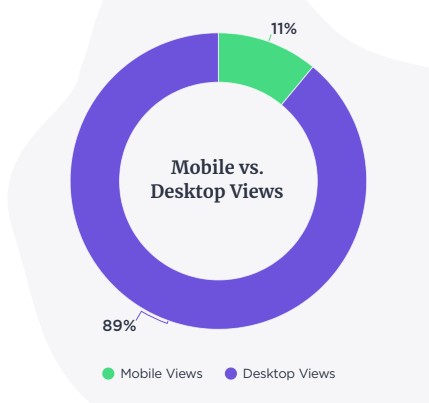
2018 Video in Business Benchmark Report
-
The highest traffic time is middle of the week
The highest traffic is on Tuesdays, Wednesdays and Thursdays with 18%.
The highest viewership on Tuesdays, Wednesdays and Thursdays is between 10 am – 13 pm, while on Mondays and Fridays the viewership shifts to 12 pm – 15 pm.
The lowest viewership for business videos is on Saturdays and Sundays.
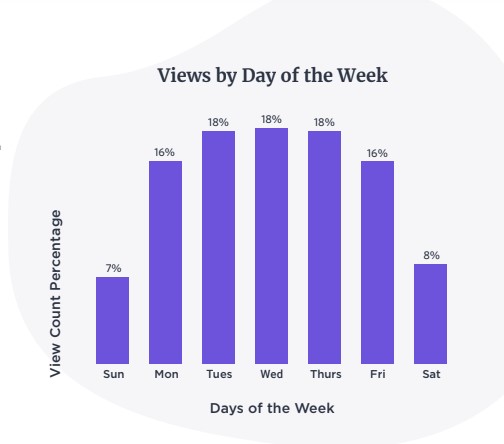
2018 Video in Business Benchmark Report
-
The industry with the highest number of videos published in total
The industry with the highest number of videos published is High Tech with 637 videos, followed by Professional Services with 274 videos and Media, Entertaining & Publishing with 247 videos.
A company in High Tech publishes on a monthly average a number of 53 videos.
The months with the highest number of videos are August, October and November – 11%.
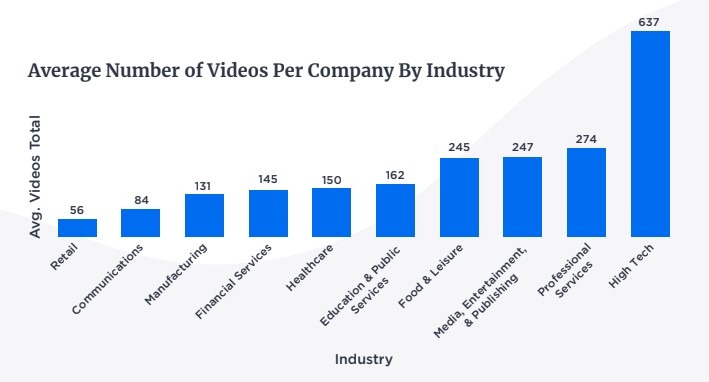
2018 Video in Business Benchmark Report
-
Video production resources
47% of large companies use a combination of internal and external resources while 54% of small businesses and 50% of medium businesses use internal resources to produce their videos.
-
Top 3 Video content by type
63% are product related videos, 59% demos, 54% explainer videos.
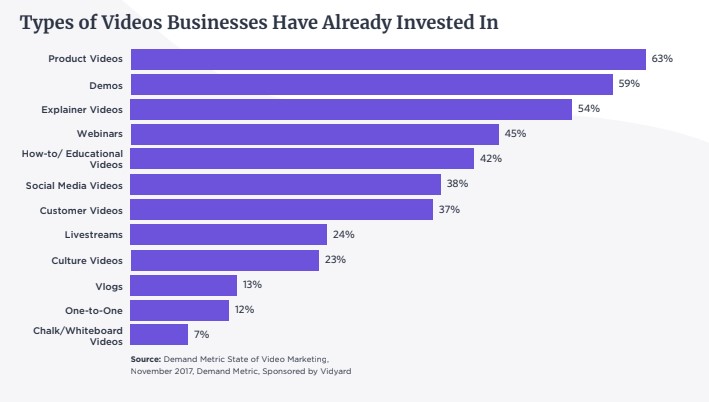
2018 Video in Business Benchmark Report
-
Top 3 video distribution channels
86% of companies host their videos on their website, 77% share them on social media and 60% place them on landing pages.
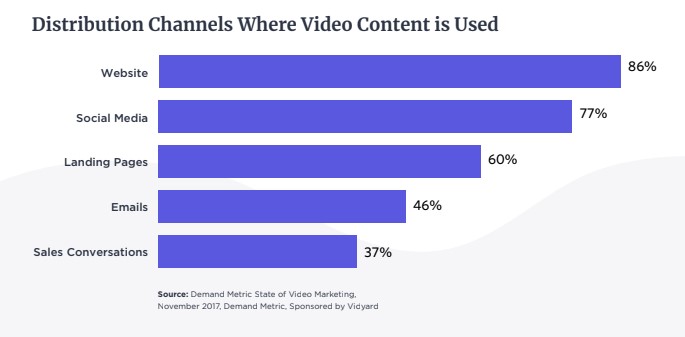
2018 Video in Business Benchmark Report
-
Video length
75% of videos are less than 2 minutes, 54% up to 60 sec.
51% of companies use basic video performance analytics, 23% use intermediate, 13% use advanced and the rest of 13% use no analytics at all which means the companies using advanced analytics are twice as likely to report the return on their video investments.
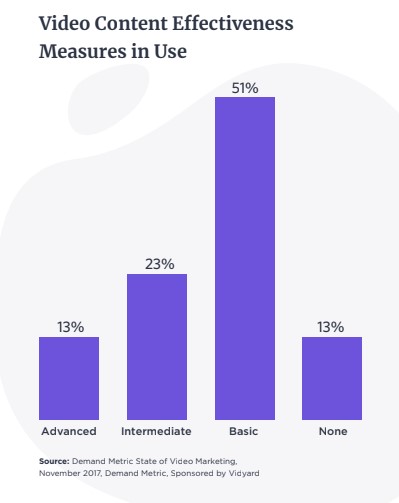
2018 Video in Business Benchmark Report
Conclusions:
- Videos published on average: 377;
- New videos published every month: 33;
- The video libraries of businesses will double within 12 months;
- Most new videos are published by businesses in High Tech and Professional Services;
- Businesses have seen a growing demand for videos throughout their customer life-cycle;
- Companies use videos for their mid and bottom marketing funnels;
- Businesses using videos on landing pages jumped from 49% to 60%, businesses using video in email jumped from 36% to 46%, video in sales conversations increased from 25% to 37%;
- Companies are either producing very short videos (up to 2 minutes) or long-form videos such as webinars;
- The average retention rate by end of a video is 46%;
- 86% of marketers using advanced analytics reported they were satisfied with their video marketing results.
How to Increase Conversions with Video Marketing
Video marketing is the latest tactic used by marketers to increase conversions.
This article will show you 3 examples of how to use video to increase your conversions.
In the past decade, social media has risen to unexpected heights and the business world could not ignore it any longer. Smartphones were the tools that enabled social media’s rapid growth. Mobile phone companies fitted their smartphones with highly performing cameras in terms of photo and video features. Statistics show that prospects and customers love to watch videos and businesses should take advantage of this.
[bctt tweet=”Discover 3 ways you can use video to increase your conversions.” username=”brand_minds”]
2018 statistics found that video drives consumer decisions:
- 64% of consumers say that watching a marketing video on Facebook has influenced a purchasing decision (source: animoto.com);
- Having product how-to videos available on YouTube are 9x more important to shoppers than celebrity endorsements;
- The most popular video content: How-to videos (52%), Product reviews (26%), Unboxing videos (25%);
- 59% of executives say they would rather watch a video than read text (source: wordstream.com);
- 60% of marketers used videos in their social media marketing in 2016 (source: socialmediaexaminer.com);
- Companies that use videos in their marketing have 27% higher clickthrough rate and 34% higher conversion rates than those that don’t (source: buffer.com).
Conversions are the mileposts of the buyer’s journey. They signal when a prospect has reached a particular moment that shows he is becoming interested in your company’s products or services.
3 examples of video marketing to increase conversions
1. Attending webinars/workshops/training sessions
Let’s assume your company sells social media marketing services to medium size firms.
One of your business strategies to attract new customers is to provide free workshops of personal branding to top level managers.
How do you influence your prospects to attend your workshops using video marketing?
You can show them a video of previous attendees talking about how these workshops helped them increase their personal brand. Video testimonials are effective marketing tools because they feature real persons. Also the viewer can see them express positive emotions when talking about their experience with your company, which is more impactful than a written testimonial could ever be.
Key takeaway: Include a powerful call to action and a sign-in form to measure your conversions!
2. Drive traffic to your website
Your company sells kitchen cabinets and you need to increase traffic to its website.
How can you increase the traffic to your company’s website with video marketing?
You can let your prospects know that if they wish to update their kitchen style and are confused about choosing a design, you have prepared a video for them. Your video can feature one of your employees presenting the latest fashion in kitchen cabinets. Prospects are looking for branded content that can deliver valuable information. High quality, informative and helpful videos are effective because they help your company build trust and positive connection to its customers.
Key takeaway: Invest in high-quality video and be true to your brand.
3. Influence your prospects to buy your product
Your company sells coffee machines.
How can you influence your prospects into buying your coffee machines using video marketing?
By making product review videos. Show your customers how they can prepare their favorite coffee, outline your coffee machine’s features and show them their benefits if they buy your product. Be engaging and entertaining!
Product review videos can influence your ranking in Google results for mobile.
Key takeaway: Don’t tell them, show them!
Expert’s statement
We asked Calin Biris, online marketing expert what are the top 3 reasons that deter marketers from producing video content.
Here is what he had to say:
One day a man comes to you and says that he has a powerful tool that can clean your house in just one hour if you use it properly. He shows you statistics about it and testimonials. He also tells you that this tool costs twice as much as any other appliance you have, but it could save you four times that amount if you use it regularly. Then he invites you to buy it. What would be your first reaction?Likewise marketers and business owners are sceptical and unprepared for using video content mainly because they don’t know how to use it and produce it (before investing in it), and are afraid to spend more than they are already paying on other traditional content.When marketers have a clear content strategy, a content plan, a budget and objectives, it is easier to decide what type of content to invest in, based on the projected results they expect. Because consumers engage more with video content and Social Media platforms are pushing this type of content to their users, the results of using video can be more efficient than in the case of using any other type of content, even if the production costs are higher.Getting back to the story, the right decision would be to buy the powerful tool that cleans your house faster, only if you are planning to keep your home neat and learn how to use that tool properly. You don’t want to waste time, money and energy using an expensive appliance in a wrong way.